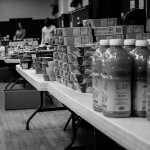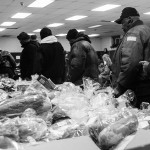By Emily Hoerner
For Chicago’s food insecure children, this season’s blistering cold temperatures may present additional barriers to learning in the classroom.
When weather is especially harsh, people turn to food services like pantries, soup kitchens and shelters more frequently, said Jim Conwell, communications director at the Greater Chicago Food Depository.
With an estimated one in six Cook County residents using food services each year, added expenses like higher utility costs in the winter cause more families to choose between putting food on the table and paying bills, Conwell said.
“The challenges of winter that anyone in our community deals with [transportation, utility bills], are magnified when you’re struggling to provide food for your family,” Conwell said. “It’s something that we see every winter.”
Last year in Chicago, 85 percent of public school children qualified for free and reduced breakfast and lunch, according to official data. With nearly 340,000 students falling into this category, food security outside school walls can be an issue.
“I don’t think we realize how important enough calories and enough good food is for learning and being successful,” said Allison Harmon, an associate professor of sustainable food systems at Montana State University.
Learning on an empty stomach
Harmon said both chronic and short-term hunger can have effects on student learning. Even when schools provide free breakfast and lunch, she said, if a student doesn’t get dinner at home they could be famished by school time.
“Certainly it can affect their ability to concentrate, it can affect their focus and their attention,” Harmon said. “They’re going to be at a disadvantage.”
Megan Mitchell, a biology teacher at Watkins Overton High School in Memphis, Tennessee, said she sees a difference in her student’s behavior at the end of the day, hours past lunchtime. A majority of students at Overton qualify for free and reduced lunch, she said.
“There’s a different sort of lethargy when a child is not feeling well versus when they don’t care,” Mitchell said. “If there’s apathy, they’re still going to be engaged with their peers.”
When students aren’t feeling well or may be hungry, they are often quiet and put their heads down, Mitchell said.
Lethargy is just one of the ways hunger might manifest in youth, according to Harmon, who has done research on the matter.
Misbehavior, or missed meal?
For 10 years Harmon said she has conducted an exercise with her college students, restricting them to Supplemental Nutrition Assistance Program, or SNAP, spending guidelines for five days. Her students had to survive the week spending only $3 a day on food.
Harmon said the nutritional constrictions greatly affected a student’s ability to perform well on exams and pay attention in classes. The food deprivation also caused rage in some participants. For a child, these effects would be even more extreme, she said.
“In some cases it’s going to look like bad behavior, it’s going to look like anger or rage,” Harmon said in reference to hunger. “In other children, it’s going to look like lethargy and for some it’s going to look like an attention deficit.”
Harmon said many teachers, attuned to their students’ regular behaviors, can recognize hunger and rectify the situation by having snacks on hand.
Mitchell, who has taught at Overton High School for four years and has mostly ninth-grade students, said she often shares her lunch with her class if students haven’t eaten.
“I spend a lot of time with these kids,” Mitchell said. “Especially this point in the year, I can pinpoint who’s going to have issues because they’re bored, or whose behavior is atypical.”
More than putting food on the table
Mitchell said the difficulties her students face probably stem from more than just food insecurity. Many of her students are from low-income families with unstable home lives.
Aryn Dotterer, an assistant professor of human development and family studies at Purdue University, said if a child is food insecure, there are probably other factors affecting his or her ability to learn. Low-income parents might not be providing quality food and a stimulating, nurturing home environment for the child.
“If you’re unsure as a parent where the money is going to come from to pay the bills and provide food, those are stressors that can affect relationships,” Dotterer said.
And those parent-child interactions matter as a child develops, Dotterer said. More needs to be done to address larger impacts of poverty on children’s learning, but immediate aid, like free food programs, are vital, she said.
In addition to hot meals at school, food insecure children in Chicago can access some of the 110 church organizations that are part of the city’s safe haven program, according to Leslie Fowler, director of nutrition support services for the Chicago Public Schools.
On snow days, Fowler said students who rely on free meals can access food at churches, soup kitchens and some Chicago Park District buildings. Children could also find comfort at school buildings, which remain open with a small number of staff, she said.
“We try to make sure that our schools are seen as safe havens,” Fowler said. “If it’s needed, we make it available.”








